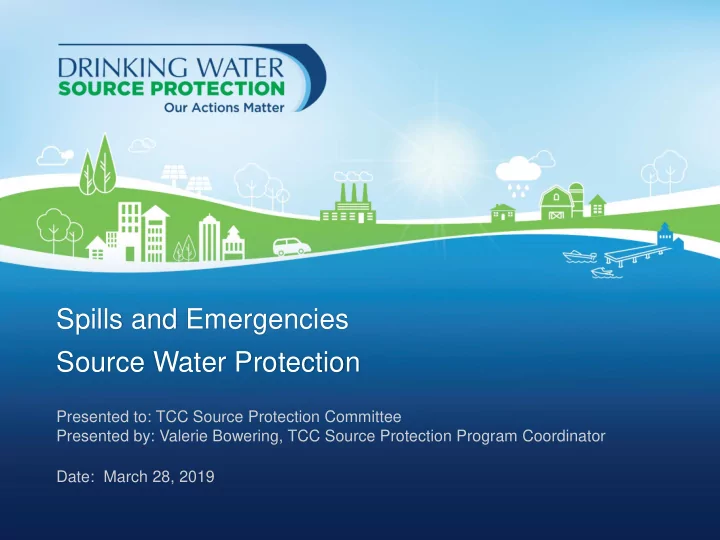

Spills and Emergencies Source Water Protection Presented to: TCC Source Protection Committee Presented by: Valerie Bowering, TCC Source Protection Program Coordinator Date: March 28, 2019
This presentation is based on my knowledge and experience of spills and emergencies. I am not a lawyer and therefore the information contained in this presentation is not legal advice. I also do not represent the Ministry of the Environment, Conservation and Parks.
Purpose of Presentation To speak to the importance of protecting sources of municipal drinking water protection during a spill event. And To give an overview of spill legislation in Ontario 3
Source Water Protection Video 4
Source Water Protection The possibility of contamination to municipal sources of drinking water due to a spill event increases depending on the vulnerability of the area where the spill is occurring. Source Protection Plans contain information on the type of vulnerability and the vulnerability score of an area. • e.g. Intake Protection Zone (IPZ) • e.g. Wellhead Protection Area (WHPA) • Vulnerability Score between 1 to 10 How close a spill is to a municipal intake or the wellhead combined with a vulnerability score of 8 or greater indicates that the spill may be significant drinking water threat 5
Source Water Protection If a spill has the potential of becoming a significant drinking water threat to a municipal source of drinking water, the drinking water treatment plant operator needs to be advised asap 6
Source Water Protection When a spill does occur, taking action to prevent migration of the spill and to clean up the spill should occur as soon as reasonably possible. Some concerns: • Spill entering a catch basin and storm sewer • Run-off of firewater • Spill run-off over land to waterbody or area around a wellhead • Timely notification of a spill to municipalities and Drinking Water Treatment Plan Operators 7
Source Water Protection Information on vulnerable areas and vulnerability scores can be found using the following mapping tool: • Source Protection Information Atlas • Having had copies of vulnerability maps in vehicles of municipal responders • Signs can be an indicator of a vulnerable area • Contacting the Spills Action Centre to seek assistance with source protection information in a spill event 8
Spills in Ontario • The notification procedure for spills in Ontario is outlined in the EPA, Part X and O. Reg. 675/98 • The person who caused the spill and the person who is in control of the pollutant spilled must notify the following people: • The Ministry of the Environment, Conservation and Parks (Spills Action Centre as per O. Reg. 675/98) • The municipality • The owner of the material spilled if not already aware • The controller of the material if not already aware
Spills in Ontario The following must also report to the MECP: A member of a police force or an employee of a municipality or other public authority who is informed of or who investigates the spill of a pollutant shall forthwith notify the Ministry of the spill of the pollutant unless he or she has reasonable grounds for believing that such notice has been given to the Ministry by another person.
Restore Natural Environment The duty to clean up a spill under Part X of the EPA is on the owner of the pollutant spilled and the person having control of the pollutant spilled “93 (1) The owner of a pollutant and the person having control of a pollutant that is spilled and that causes or is likely to cause an adverse effect shall forthwith do everything practicable to prevent, eliminate and ameliorate the adverse effect and to restore the natural environment .”
Restore Natural Environment During a spill, the province has a regulatory role in ensuring the protection of the environment and human health and under the EPA has the power to issues orders (to others) or directions (to employees). Role of the Province (MECP): • Provides support to municipalities • Working with other agencies, determine the extent of environmental and health impacts • Enforces environmental legislation • Does not clean up a spill unless under a Minister’s Direction
Restore Natural Environment A municipality also has a role in spill response: • Duty to report • Right to respond and right to compensation under the EPA • Regulatory role (by-laws) • Provides first response • Responsible for municipal infrastructure Spill response is a shared responsibility between the province and the municipality 13
Some Considerations • A spill is to be reported to both the MECP and the municipality • public authority not required to report to municipality – i.e. police officer - municipal internal procedure required • The MECP isn’t a first responder • The ministry and the municipality are dependent on the information being reported in order to do an initial assessment • This may impact field response times • Information may change throughout the course of an event • Not every spill is an emergency 14
Some Considerations Important to have internal procedures to communicate spill information and to coordinate response. • Who receives the notification of a spill • Who coordinates the response and provides additional notifications • What are the different roles and responsibilities within the organization
In Closing • There are legal requirements for reporting and cleaning up of spills • Understanding risks in the community i.e. municipal sources of drinking water • Understanding roles and responsibilities and having a communication plan • Ability to access and understand source protection information 16
References https://www.ontario.ca/page/report-pollution-and-spills http://www.ontla.on.ca/library/repository/mon/19000/277331.pdf https://www.ontario.ca/page/municipal-drinking-water-systems-licencing- registration-and-permits 17
Recommend
More recommend